Kootenay Community Bat Project
Spring is here, and with warmer nighttime temperatures our BC bats are now returning to summer roost sites.
One of our more familiar species in buildings and bat boxes is the Little Brown Myotis. Like all B.C. bats, the Little Brown Myotis is an essential part of our ecology, consuming many insect pests each night. Unfortunately, the Little Brown Myotis is endangered in Canada due to white-nose syndrome, a fungal bat disease. The fungus responsible has recently been detected in BC for the first time, sounding the alarm bell for BC’s bats.
A simple way to support bats is to participate in the BC Annual Bat Count this June. The BC Community Bat Program is requesting colony reports and volunteer assistance for this citizen-science initiative that encourages residents to count bats at local roost sites.
The BC Annual Bat Count is easy, family-friendly, fun, and safe, not to mention vital for monitoring bat populations. If you are new to counting or wish to meet other volunteers, the Kootenay Community Bat Project (KCBP) is organizing workshops in different regions of the Columbia Basin. In Creston, bat counts will be taking place on June 6 and 14, as well as July 12 and 27 from 8 to 10 p.m. Participants will be meeting at the Kootenay-Columbia Discovery Centre Parking Lot. For more information, contact Tina Watters at wildlifetech@crestonwildlife.ca or check out the registration page at www.eventbrite.com/e/bat-roost-counting-tickets-642311499987.
“The counts are a wonderful way for people to get outside, learn about bats, and be involved in collecting important scientific information” said Elodie Kuhnert, co-ordinator of the KCBP. Volunteers wait outside a known roost site, such as a bat-box, barn, or attic, and count bats as they fly out at twilight. A guano sample can also be sent in to identify the species of bat at the roost site. Find more information at bcbats.ca/get-involved/counting-bats.
The count data helps biologists understand bat distribution and monitor for impacts of the devastating bat disease called white-nose syndrome. White-nose syndrome is an introduced fungal disease, fatal for bats but not for other animals or humans. Results from the Bat Count may help prioritize areas in BC for research into treatment options and recovery actions.
Funded by the Habitat Conservation Trust Foundation, the Forest Enhancement Society of BC, the Habitat Stewardship Program, the Columbia Basin Trust and Kootenay Local Funds, and with support of the BC Conservation Foundation and the Province of BC, the BC Community Bat Program provides information for people dealing with bat issues on their property or who have questions about how to attract bats. To find out more about bat counts or white-nose syndrome, to report a dead bat, or to get advice on managing bats in buildings, visit www.bcbats.ca or call 1-855-9BC-BATS.
